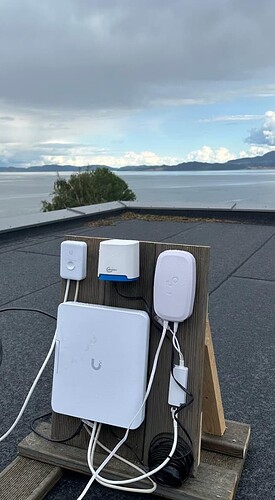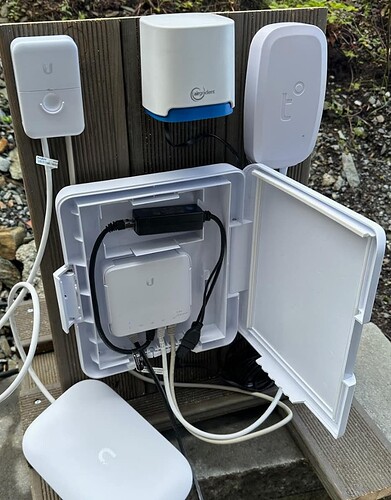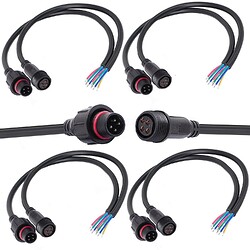I want to find the right power adapter for outdoors but I can’t seem to find anything that’s outdoor rated or IP68. I don’t want to start a fire, or blow up an expensive piece of equipment by buying a cheaply made USB-c adapter from amazon. I really wish this product came with everything already, being over $200. It seems a bit of a turn off, I would have ordered this by now if it came with the correct adapter. Seems really DIY type of stuff for this much money, big turn off and let down.
The unit comes with a 4m longUSB cable and most people feed the cable back into the house and connect it to a power plug on the inside. Then no need for an ip65 rated power plug.
One reason we don’t supply power plugs is that there are so many different standards in the world and it makes our internal logistics a lot more difficult. Also as per above, we don’t know if the user plugs it in on the inside or outside.
I do agree that it is unattractive that it doesn’t come with everything needed in the box. Especially if you have particular requirements and then users have to go buy yet another device to be ready to use.
I get there are logistics issues, but it is a disservice to the purchasers
Not sure if I agree.
How many old USB chargers people have floating around from old smart phones etc. ?
Our monitors have little power requirements and pretty much any charger normally works.
We are very committed to sustainability and not supplying it by default reduces our carbon footprint.
An option we might look into could be to offer it as an optional purchase.
PS:
(Obviously if people need an ip charger for outdoors that’s another story but we strongly recommend to feed the 4m cable into the house and plug it in indoors. )
My experience has been completely opposite. I’m a tech guy and have my obligatory box of random cables along with unused USB wall adapters, and almost none of them meet the requirements.
On the Indoor product page it says 2A 5V USB A Power Plug is Required
I looked through 4 different spare wall adapters that I have sitting idle and only one is 2A. An adapter that came with a Wyze camera is only 1A which doesn’t meet the requirements. A couple of Amazon adapters are either 1 or 1.2 A which don’t meet the requirements. I have an adapter with 2 USB outputs, but it is 2.1 A total which means if I use it with a second device as it was intended, it won’t meet the requirements. I only have one no-name branded adapter that does 2 amp. Any other “spare” devices are strategically located where I need charging to happen, and I don’t want to unplug an AirGradient just to charge a phone.
I’ve given devices to family members and they either had to buy an adapter that meets the requirements, or they had to place it in a non-ideal location so it could be located where a USB outlet is available.
In the past, people have been told that the S8 needs a very stable power supply, and providing one that is suitable would prevent end users from having issues:
S8 CO2 reading of -2 - AirGradient Forum
Question about overall calibration and why my numbers are all over the map? - Components - AirGradient Forum
Looking at other devices that are intended to be plugged in all the time, they often do ship with adapters, such as:
Wyze Cam v4 | 2.5K HDR, Indoor/Outdoor, Wired Security Camera | Wyze
Indoor Security Camera C120 | 2K & Night Vision - eufy US
If I was paying for these devices and they came with just a USB cable and no adapter, I would also being incredibly frustrated. But I think the understanding is that these devices will be plugged in all of the time, so they come with the required hardware to meet that need.
Thanks for sharing your perspective. Very appreciated. I hope some others might also share their thoughts. I would love to hear more opinions.
By the way, most likely the monitors would only need 1-1.5A but we were a bit caution in the specs. Also, I believe the S8 issue you mentioned might have had other issues.
For indoor, I think the USB-C is perfect. The chargers I have used have just worked, but I might just be lucky.
For outdoor, I don’t think USB-C is a good fit. At least not in my wet/snowy/windy environment. I would rather see something like a IEEE 8092.3af through a RJ-45 where you could attach it in something that is more sealed. Tempest e.g. uses RJ45 for their power, Power Booster Accessory – Tempest PBA Cable Extension Kit – Tempest. Tempest doesn’t use a standard PoE technology, which makes it slightly harder - you need an extra dongle.
(With a RJ45, I would rather see data going over the wire than over wifi also, since it would allow sensor to be placed outside of wifi range.)
My solution is to drag PoE+ through outdoor specc’ed RJ45 to an enclusure closer to the sensor (I use a Switch Flex Utility - Ubiquiti Store), then I have a PoE->USB converter inside it, and drag an USB the last few meters. It will be interesting to see if the USB-C on the sensor stays dry and connected during the winter.
I also had trouble with USB-C, but I also wanted to break out GPIO 4 + 5 + GND to outside the AG unit.
I ended up building a PCB that connects to the internal I/O port, and from that PCB I have an IP68-rated RGB LED connector coming out carrying both power and the two GPIOs. Very similar to this:
I had to desolder the indicator LED in order to get a hole large enough to pull the new wire through to the inside of the AG. 5V gets produced by a Meanwell HDR well away from any elements (also quite a bit more than 4 meters away.) There is a little bit of voltage drop, but nothing serious enough to warrant any concern.
Conversely, while I was waiting for my addon-PCB to be manufactured and delivered, I was powering AG with a regular USB brick covered by a rudimentary plastic guard and it managed to not ex/implode throughout those few weeks so  .
.
Yes, this is an issue – I’m not going to drill a hole through the walls in my apartment, and it’s quite hard to find
There’s one option that I can see in Norway, from Dustin Home – which means it should be available in the Nordics:
hxxps://www.dustin.no/product/5011375668/utendors-stromadapter-usb-c-ip44-15m-svart
I also see Purple Air offers an outdoor USB unit, but with micro-USB. You could use an adapter?
Better yet would be if AirGradient gets in touch with the manufacturer GlobTek and offers a USB-C plug for sale (they make the one for Purple Air):
I don’t understand why the power supply current is specified at 2A.
Both monitors (indoor and outdoor) are specified at requiring 2A at 5V. I measured my indoor monitor with a cheap USB voltage/current meter (which is said to be accurate to within ± 1% over a 0-3A range) and the max I have seen it draw is 180 mA with WIFI on and LEDs+OLED screen set to full brightness.
I have not tested while flashing it but I would be surprised to see it pull much more than that. A 0.5A power supply should provide more than 2.5 times enough power.
Are there other situations where the monitor needs more than 1A? I fully support the choice of not providing a power supply bundled with the monitor but, in my opinion, over-specifying the current requirements somewhat defeats the purpose if people are thinking that whatever power supplies they might have lying around will not be enough and purchase an overkill one on the side.
Yes, in most cases the monitor runs just fine with lower than specified power adapter.
I will check with our engineers and see if we can clarify this better.
Yeah. I’m in the same boat where I have an unbelievable number of old USB power supplies laying around. None of which supply the 2A listed as the requirement. Using a Klein ET920 I haven’t seen it draw more than .20A during the setup process.
I find it short sighted as well that you don’t even offer an option to buy a power supply with matching specifications for your sensors. (Granted I’m new and might’ve missed that).
Can you / your engineers please provide specific guidance on what is acceptable so customers can avoid damaging them with incorrect power supplies.
Love this idea. This is exactly what I’m going to do.


